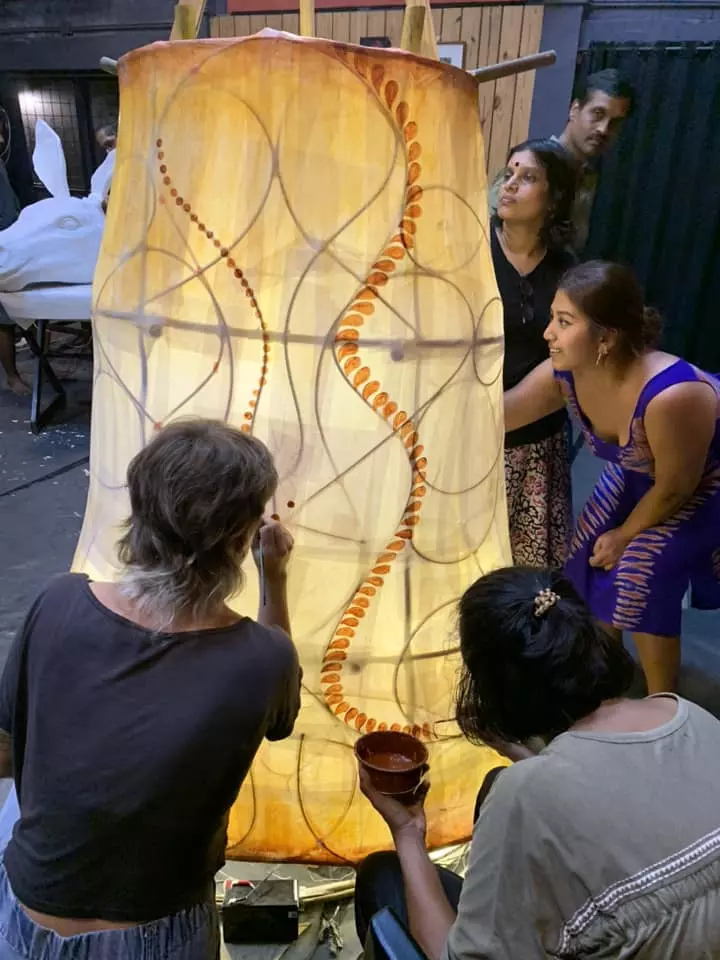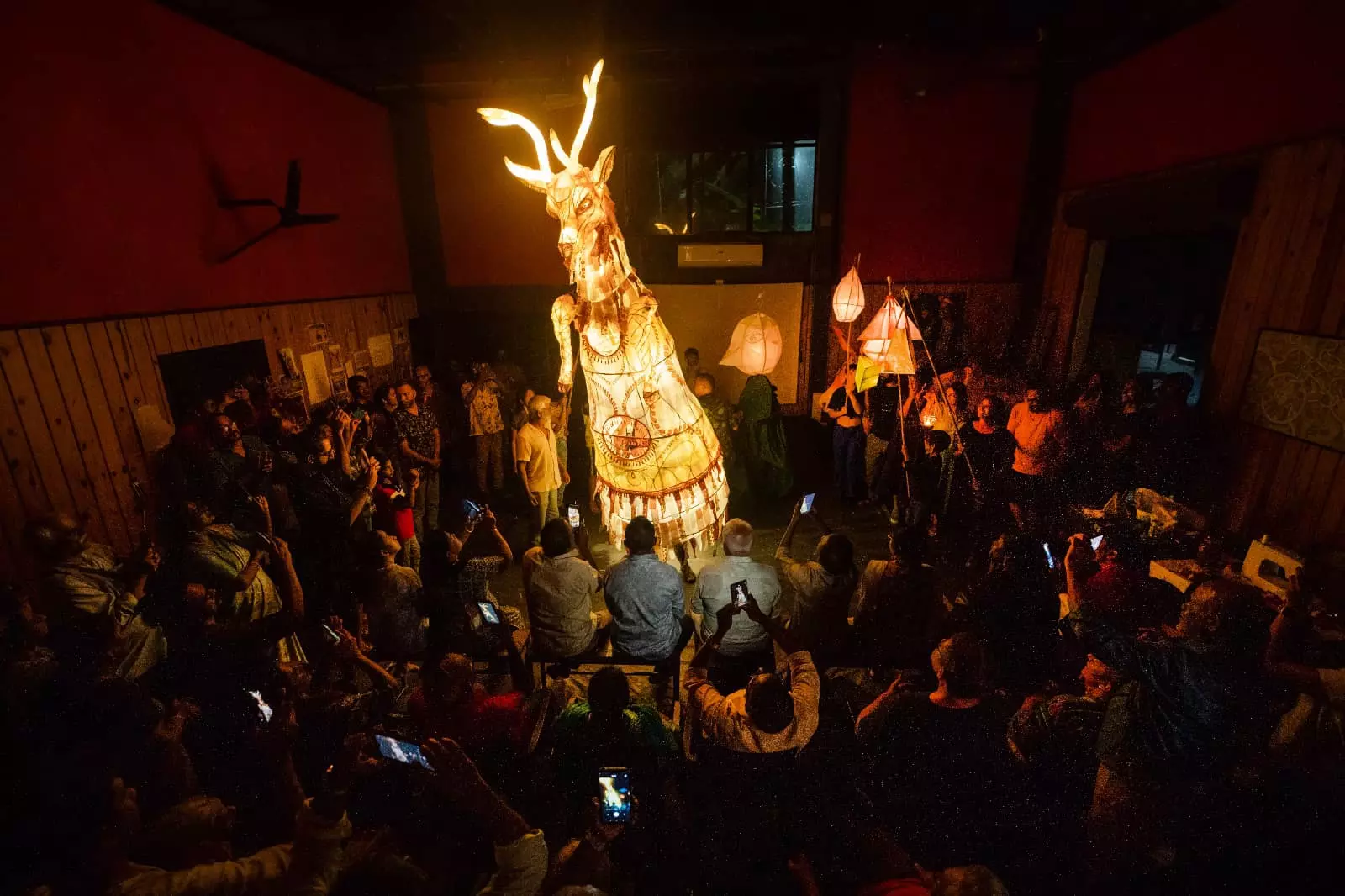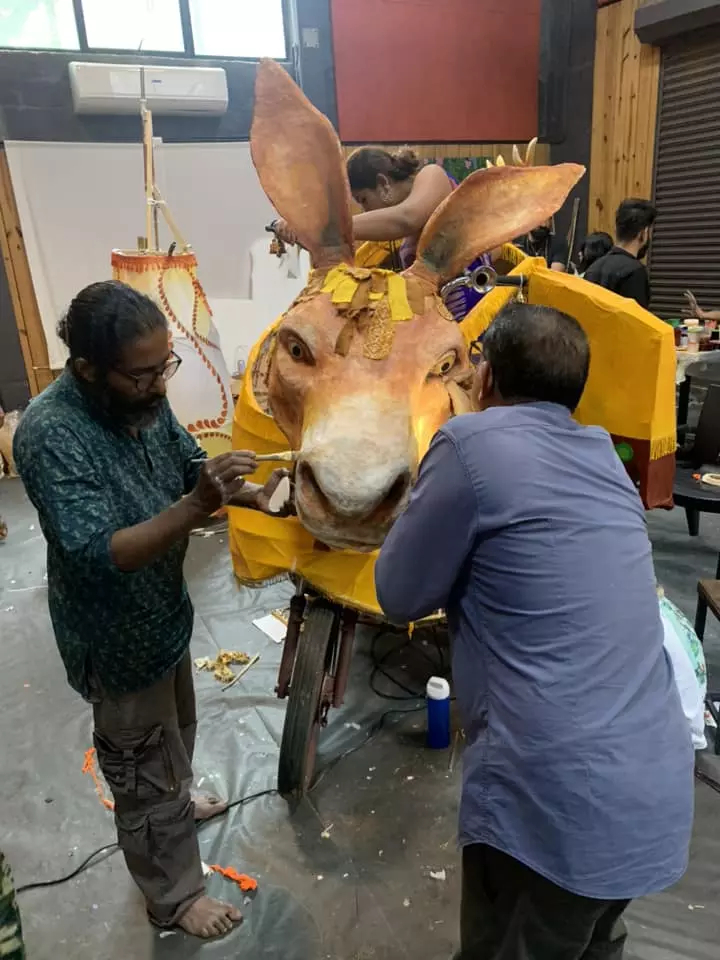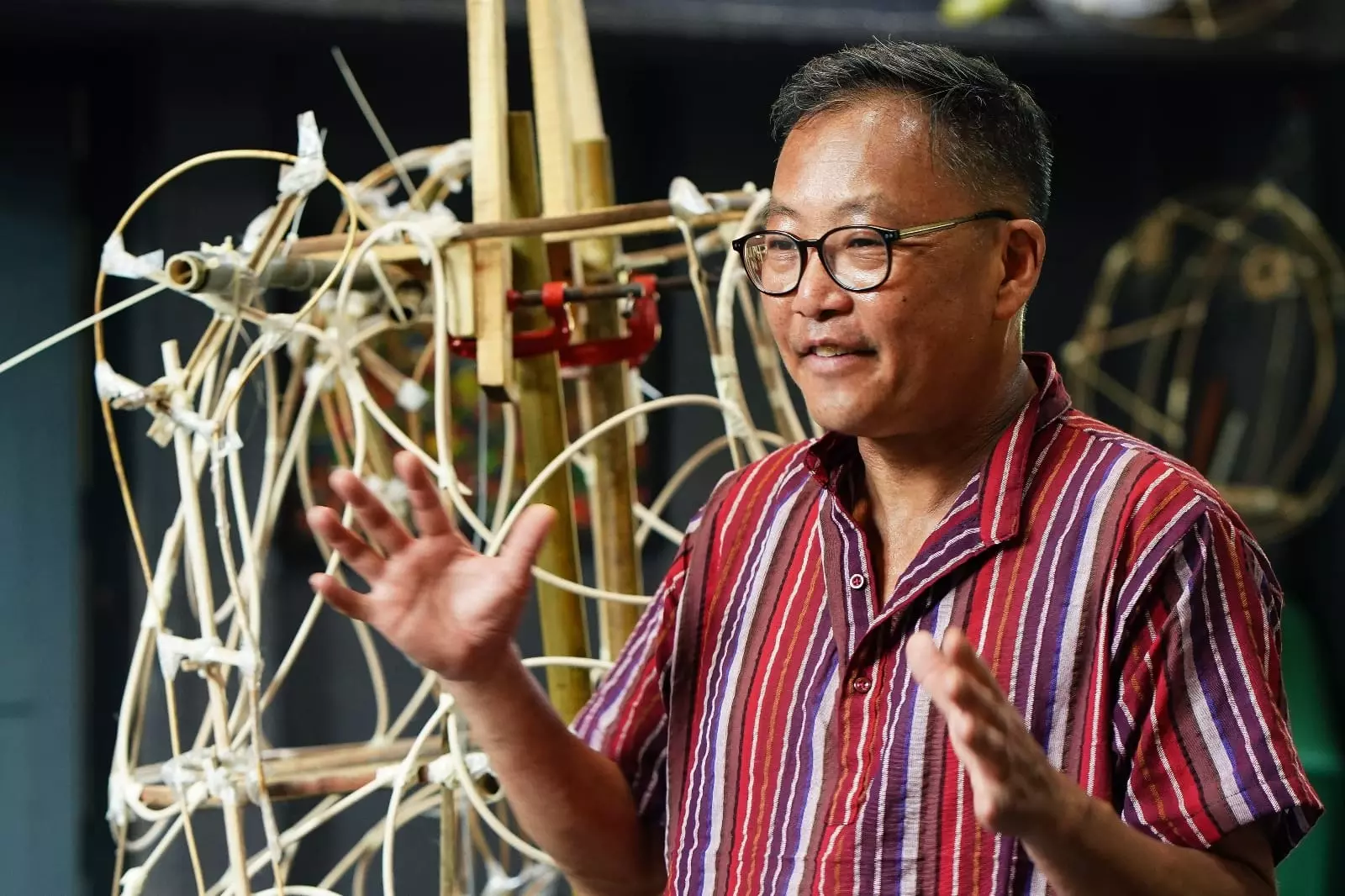
- Home
- India
- World
- Premium
- THE FEDERAL SPECIAL
- Analysis
- States
- Perspective
- Videos
- Sports
- Education
- Entertainment
- Elections
- Features
- Health
- Business
- Series
- In memoriam: Sheikh Mujibur Rahman
- Bishnoi's Men
- NEET TANGLE
- Economy Series
- Earth Day
- Kashmir’s Frozen Turbulence
- India@75
- The legend of Ramjanmabhoomi
- Liberalisation@30
- How to tame a dragon
- Celebrating biodiversity
- Farm Matters
- 50 days of solitude
- Bringing Migrants Home
- Budget 2020
- Jharkhand Votes
- The Federal Investigates
- The Federal Impact
- Vanishing Sand
- Gandhi @ 150
- Andhra Today
- Field report
- Operation Gulmarg
- Pandemic @1 Mn in India
- The Federal Year-End
- The Zero Year
- Science
- Brand studio
- Newsletter
- Elections 2024
- Events
Of giant puppets and lantern puppets

When renowned puppet-maker and performer Andrew Kim was in New Delhi in October, he made a dung beetle, caterpillar and dung ball. He taught 12 Indian artists to build, light and perform these puppets.Andrew then went to see Puran Bhatt, a 7th generation master of Rajasthani string puppets. He spent hours with him, talking about puppetry and culture from traditional styles to...
When renowned puppet-maker and performer Andrew Kim was in New Delhi in October, he made a dung beetle, caterpillar and dung ball. He taught 12 Indian artists to build, light and perform these puppets.
Andrew then went to see Puran Bhatt, a 7th generation master of Rajasthani string puppets. He spent hours with him, talking about puppetry and culture from traditional styles to contemporary techniques. The next day, he went to see the Taj Mahal in Agra. On the day of Dussehra, a Hindu festival celebrating lord Rama’s victory over Ravana, Andrew found the effigies of the demon king being burnt on the streets of Delhi.

A hedgehog that Kim made in Rotherham.
“Living my best puppeteer life here,” he wrote it down on his sketch pad. Andrew is in search of folk and cultural elements in the countries that he visits and it is this connection that gives his puppets a contemporary sense of shape and movement.
Puppets have existed in one form or another in nearly every culture throughout human history, according to scholar Eileen Blumenthal. “From the intriguing shadow puppets of Java to the romantically challenged Miss Piggy, from African carved-wood actors with outsize genitalia to merry maniac Mr Punch, puppets are incredibly diverse, reflecting the varied cultures, environments, and personalities of their creators,” writes Blumenthal in Puppetry: A World History, an illustrated volume which provides a comprehensive overview of the history and techniques of puppetry, examining the unique nature and abilities of puppets and illustrating the countless roles they (and their creators) have played in societies across the globe for thousands of years. The art of puppetry varies from place to place, and culture to culture. Considered the indigenous theatre of India, puppetry has been the most popular form of entertainment for people, particularly those in the rural areas since time immemorial.

Artists make a lantern puppet
Andrew’s puppets are different, as they bring to life the shapes and movements drawn from the day-to-day crisis such as climate change, habitat loss, global warming, migration etc. “One should have a clear idea about the puppet that one is going to make. Movements and sizes have their own respective roles to play. With innovative movements, a puppet can establish a profound connection with the viewers,” said Andrew, who is known for his giant puppets and community-focused performances across the world.
Born in Korea, Andrew was educated in the US. He has been performing puppet and mask plays, parades and events for more than 30 years. Andrew was interested in theatre first and it was his association with theatre that eventually led him to puppetry. “I was interested in literature and theatre. I Wanted to be a writer. My association with puppets began when I got a job in a puppet theatre group. It was from this theatre that I developed a strong connection with puppetry,” he said. Andrew worked at “In the Heart of the Beast Puppet and Mask Theatre” in Minneapolis for almost 10 years, learning all elements of making, performing and directing puppet plays, parades and large-scale spectacles. He then moved to Bread and Puppet Theatre and studied traditional Korean and Balinese mask theatre.

A giant puppet that Andrew Kim made as part of the recently coclused workshop in Kochi.
At the recently concluded giant puppets workshop at “Ala” (a space for diverse artistic expressions, cultural exchange, and community building) in Kochi, he taught 12 artists in making a giant puppet and a lantern puppet. “We want to make puppets as big as possible. But size at times brings in trouble, as it is difficult to manage during heavy winds. I make my own choices based on situations and circumstances,” he said. Why is Andrew fond of big puppets? “Indoor performances are meant for a particular group of people. But outdoor shows are different. There are immense possibilities of communication between the puppets and the viewers. When you perform outside and that too in front of various people, you can establish the connection easily and more effectively,” he added.
Even though Andrew picked up the basics of puppetry when he was in the US, it was during his life in the UK that he became more productive and innovative. When he moved to England in his mid-30s, he got influenced by some traditional styles inspired by a group of Caribbean and Jamaican artists. It was a period of learning new techniques and styles. Andrew soon started making lantern puppets, drawing inspiration from a traditional Japanese festival.

A giant puppet in the making
The materials he uses for making puppets include clay, paper mache, baboo, reed, fibreglass moulding, cloth, papers etc. “I look for the materials available in the locality. It should be eco-friendly. I try to limit the use of plastic,” said Andrew, who teaches giant puppet and lantern puppet workshops where he builds one or two new giants with up to a dozen artists in two weeks. He has led these masterclasses in England, Scotland, Denmark, Norway, Switzerland, Bulgaria, South Korea and several cities throughout the USA. His giant puppets such as Yeshe the Yak, Hippo, Musk Ox, Kit and Caboodle and Ghosh are popular across the world. If you look at the way Andrew addressed issues like migration, you will know how productively he uses puppetry to establish contemporary issues. With miniature puppet shows inside a big, rolling mule puppet, the timeless theme of migration is packaged up in Thingumajig’s street act called “Kit and Caboodle.”

Artists at the workshop making a giant puppet
It was while working as performers on a Horse and Bamboo production in 2002 that Andrew met Kathy. After several years commuting across the Atlantic to visit each other, they married and settled in West Yorkshire and started Thingumajig Theatre in 2006. Thingumajig Theatre creates and performs innovative puppet plays and interactive giant puppet street acts. Based in West Yorkshire, their puppets have played throughout the UK and 17 other countries and have been seen on television and a major Disney film.
Design and movement are important in puppetry. “Design attains significance when it comes to puppetry. One has to design one’s puppet. One should know the movements that his puppet is going to perform. Even though it looks simple, there are many minute details that one has to focus on while making a puppetry. It is challenging,” he said.

Andrew Kim at the recently concluded workshop in Kochi.
Speaking on the possibilities, relevance and challenges of traditional Indian puppetry, Andrew said, “Each puppet has a story behind it and each one has a reason behind its making. India has a great tradition of puppetry. We recently spent a day with some traditional Kerala puppeteers at Harisree Tholpavakoothu Kalakendram. We looked at puppets, some 400 years old, and saw the couplet verses and explanations written on palm leaves. A master puppeteer must be able to sing 2100 verses and their explanations. We also saw the chisels they used and then toured several puppet stages which are permanent structures at temples for the goddess Bhadrakali. It was a great experience,” said Andrew, who is the founder and former artistic director of the Hebden Bridge Handmade Parade and the Todmorden Lamplighter Festival and currently the artistic director of Thingumajig Theatre, UK.
Even though puppetry is universal, the style and practice differ from place to place. “When I met Rajasthani string puppet maestro Puran Bhatt, he wanted to know how I make my giant heads (of puppets) move. He showed us some of his traditional and modern styles. The Rajasthani style does not use a control bar, only hands and fingers in various arrangements. The magician uses a short bamboo rod to help hold the 16 strings together,” he said.
The recently concluded ten-day giant puppet workshop at Ala in Kochi was a great experiment in this format. At least 12 theatre practitioners and artists lived and worked together to create two giant puppets under the guidance of Andrew. “We worked with a lovely team of artists from Kerala and around India and one from France to make a donkey built on a bespoke tall trike and a lantern deer inspired by our Ghost Caribou. On the last day of the workshop, we held a ceremony to transition the assembled building materials into beings which have the potential for coming to life,” said Andrew.
